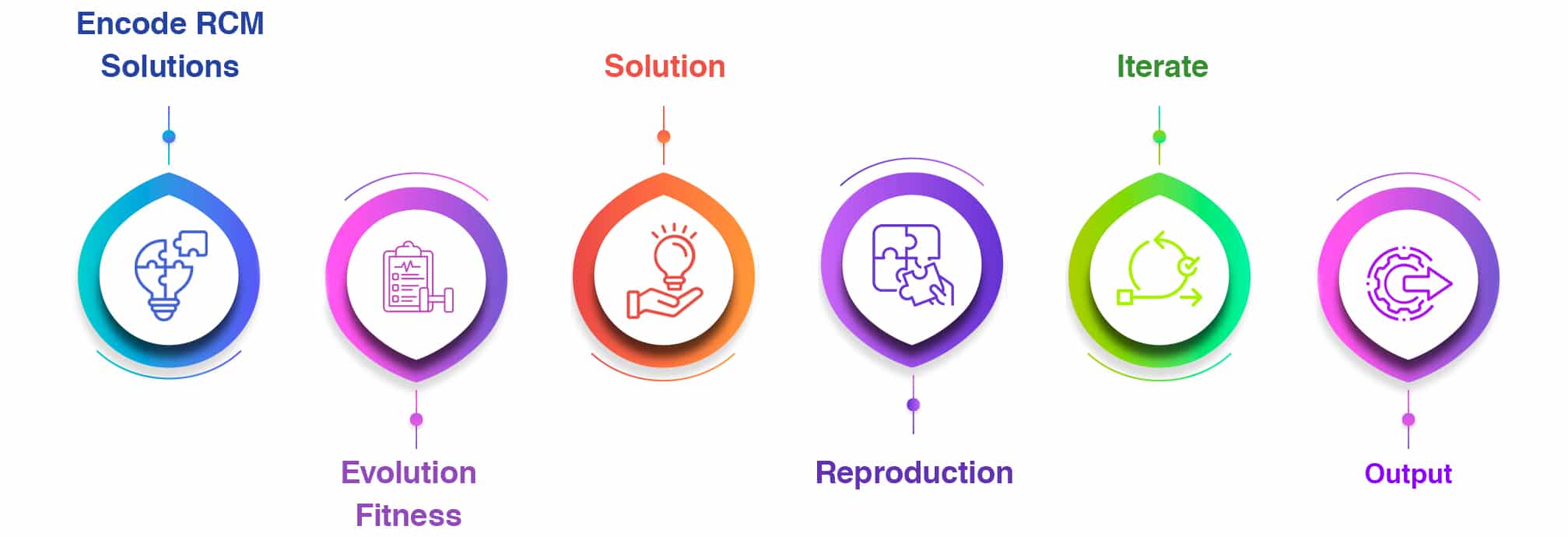Optimize Healthcare Revenue Cycle Management with Evolutionary Algorithm Approach

In healthcare operations, revenue cycle management (RCM) plays a critical role in ensuring the financial well-being of provider organizations. The RCM process encompasses all the administrative and clinical functions that contribute to capturing, managing, and collecting patient service revenue. From registration and appointment scheduling to clinical documentation, coding, billing and accounts receivable follow-up, each component of the RCM lifecycle impacts an organization’s ability to get paid for the services they deliver.
Even seemingly minor inefficiencies or lapses in areas like claims processing, denials management, or process hand-offs can significantly disrupt revenue capture. And with constantly shifting regulations, payer rules, and operational factors like staffing levels or technology deployments, healthcare RCM is an inherently challenging optimization challenge.
This is where advanced techniques like evolutionary algorithms can provide powerful solutions for enhancing RCM performance. Drawing inspiration from principles of biological evolution, these optimization approaches use processes akin to genetic variation and natural selection to iteratively evolve populations of candidate solutions towards optimal or near-optimal compositions tailored to the complex objectives and constraints of healthcare RCM.
How Evolutionary RCM Optimization Works?
At a high level, evolutionary algorithms for healthcare RCM optimization follow a repeating cycle of evaluation, selection, and genetic variation across populations of candidate solutions.

Encode RCM Solutions – An initial population of RCM operating models and configurations are encoded into structures suitable for evolutionary computation. This may involve representing factors like.
- process flow
- decision rules
- resource allocations
- technology deployments
- third-party service levels, etc
Evaluate Fitness – Each solution’s “fitness” is evaluated according to a quantitative objective function designed to measure key RCM performance metrics like
- revenue capture rates
- denial rates
- cost-to-collect ratios
- discharged-not-final-billed timelines
- cash acceleration
Selection – The fitter solutions are preferentially selected to propagate attributes to the next generation based on their relative quality scoring via techniques like tournament selection or roulette wheel sampling. The weaker solutions are culled. This ensures better performing solutions influence the next generation.
Reproduction –The selected solutions reproduce a new generation through genetic operations like.
- crossover (combining components of multiple high-fit solutions)
- mutation (randomly modifying parts of solutions)
- Iterate – This cycle of fitness evaluation, selection and reproduction iterates, with the solution population ideally evolving towards increasingly higher RCM performance over successive generations until a stopping criteria is reached
Output – The solution with the highest fitness score represents the optimized RCM model configuration.
This evolutionary approach is well-suited for healthcare RCM optimization due to the immense complexity stemming from the sheer number of interwoven process components, transactional volumes, regulatory and administrative rule sets, not to mention the inherent unpredictability and dynamism present across patient populations, service mixes, contracted payers, and market factors.
Key Applications and Benefits
Evolutionary techniques are being applied to enhance myriad aspects of healthcare RCM. Some prominent areas include:
- Front-End Process Optimization – Finding optimal patient access models for areas like scheduling, registration, eligibility verification, pre-authorization, point-of-service collection, and upfront price transparency to maximize clean claims and avoid denials
- Clinical Documentation and Coding – Determining ideal setups and workflows for areas like EMR templates, documentation integrity, charge capture, and skilled coding to ensure claims are coded properly and supported by clinical evidence
- Denials and Appeals Management – Identifying optimal processes, decision rules and resource allocations for denials prevention, root cause analysis, appeals prosecution and payer negotiations
- Accounts Receivable and Collections – Optimizing priorities, workflows, allocations and scripts for areas like claims submission, remittance posting, payment posting, customer service, and bad debt collections
In addition to tailored applications, some key benefits of deploying evolutionary RCM optimization approaches include:
- Holistically Optimized End-to-End Processes – Evolutionary search can incorporate the full scope of interconnected RCM components and objectives into a unified optimization framework
- Continuous Adaptability – Solutions can dynamically evolve in response to changes in regulations, payer policies, consumer preferences, competitive landscapes, etc.
- Balanced Trade-Offs – With multi-objective evolutionary search, organizations can find solutions that optimally balance priorities like revenue capture, cost control, customer experience, compliance, and more based on their specific needs
- Process Visibility and Auditability – In addition to optimized configurations, evolutionary compute techniques can yield interpretable visualizations and decision logic to enhance process transparency and governance
Future of RCM Using Evolutionary Approach
As value-based care models and consumerization trends continue reshaping healthcare’s financial dynamics, effective revenue cycle performance will only grow more vital for provider organizations’ operational and fiscal well-being. By harnessing the power of evolutionary search and optimization, these organizations can systematically enhance one of their most critical administrative processes in the face of ever-increasing complexity.